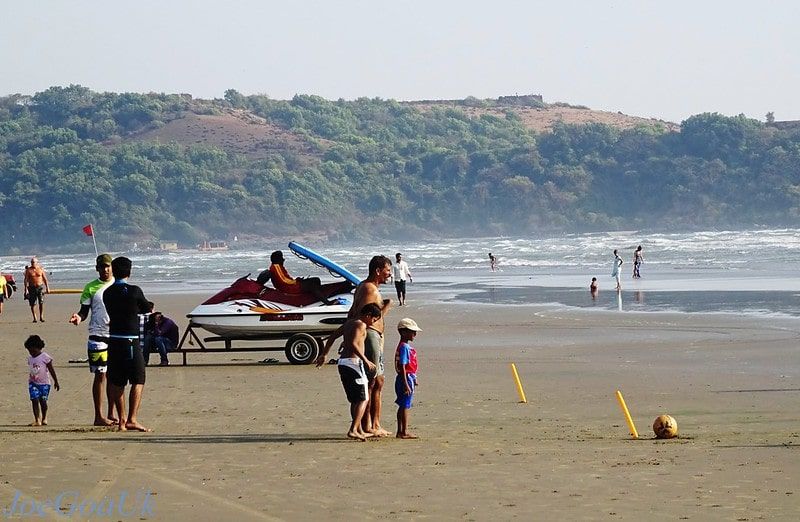Goa: Sari on the beach
He is used to tourists getting into scraps and ignoring warnings, but Kamat is most concerned about those ‘who step into water in lehngas and jeans’.
Written by Harsha Raj Gatty Panaji | Updated: March 20, 2016 10:39 IST

Kamat has 60 “rescues and emergency interventions” to his credit. Photo by Harsha Raj Gatty
It’s 9.30 am on a Tuesday and around 4,000 people have already gathered at Calangute beach in North Goa. Oblivious to the red flag waving in a corner, a sign that the beach is closed, about half the visitors have ventured into the shallow waters. A few metres away, Shekar Kamat has noticed the violation.
Dressed in a red and yellow nylon t-shirt with ‘LIFEGUARD’ inscribed on the torso, Kamat, 26, is guarding a 1-km shoreline of Calangute beach. Every morning at 9 am, Kamat and his team of 27 men start their day from the 12-foot-high ‘Lifeguard Tower’ and watch over thousands of visitors who flock to the beach.
In January this year, nearly 650 lifeguards employed by Drishti Lifesaving Services Private Ltd, the private agency tasked with providing lifeguard services at 41 beaches across the 105-km coastline of Goa, went on strike demanding regularisation of services and payment of minimum wages. The 14-day protest ended with the state government calling the demands “illegitimate”.
Advertisement
But the strike is not on Kamat’s mind right now. With the numbers swelling at the beach, he has his task cut out.
“Point 3 (lifeguard), whistle and call out to the man in the white shirt. He has ventured too deep into the sea,” says Kamat in Konkani, speaking into his walkie-talkie while simultaneously monitoring the other visitors with his binoculars.
“Tourists feel they are on vacation, so they should be allowed to do whatever they want. But there are rules,” says Kamat, who earns Rs 10,000 a month and was recently judged the fastest swimmer at the Inter-Lifeguards Competition. He has 60 “rescues and emergency interventions” to his credit so far.
One of four siblings, Kamat begins his day at 5 am. A quick breakfast with his family and he is ready to leave his home in Sanquelim, from where he covers the 35-km distance to the beach on his motorcycle. He has studied till Class VIII and is fluent in Konkani, English and Hindi and throws in a little Portuguese too when needed.
By 10 am, the other lifeguards, all between 21 and 35, are ready to leave the tower and take their positions on the beach. Their gear: a pair of sunglasses, a cap, rescue tubes, a whistle, oxygen masks and their walkie-talkies. Another group at the tower is busy examining the first-aid kit, the CPR machine (a portable emergency revival kit) and the expiry date of the ointments in the stock. Soon, a red patrol jeep drops a lifeguard each at every 100 metres on the beach. The lifeguards go on to take their positions on the five-foot-high chairs placed near the shore.
Advertisement
At 10.05 am, Kamat tells a lifeguard on the beach to replace the red flag with a red-and-yellow one, which signals the opening of the beach to the public. Next, he calls another member to place a black-and-white flag to the right of the tower, a sign for water sports companies to start their services.
With the fresh batch of lifeguards at their positions, Kamat updates sector head Shantaram Rane about the number of people on the beach and then marks the attendance of his team. “Multi-tasking is a part of this job,” he says, taking a big gulp of water from his bottle. Given the harsh sunlight on the beach, a lifeguard needs to drink at least 2 litres of water during his eight-hour shift.
“Lifeguards look much older than their age because of constant exposure to sunlight and dust,” says Kamat. Recently, Kamat’s 21-year-old brother, Gauresh Kamat, too joined the lifeguard team. “He often accompanies me to the beach, but has a lot to learn,” he says.
Advertisement
“Calangute tower, come online,” says a voice on Kamat’s walkie-talkie. It’s a lifeguard on the beach. “There’s a rip current (strong and narrow current) on the extreme left of the tower,” warns the lifeguard. Kamat picks up his binoculars and focuses on the spot. “Point 1, increase the red flag area by 10 meters,” says Kamat, directing a lifeguard closer to the rip current area.
“Rip current areas are usually marked, but sometimes, like this one, they hit the safe zones too. These currents can sometimes drag you 50 metres into the sea,” says Kamat. He has other concerns too. “Some domestic tourists step into the water wearing saris, lehngas and jeans. These clothes hold more water and make the victim heavier during rescue operations,” he says.
At 1.10 pm, Kamat declares “dry-dock” on the walkie-talkie. That’s a call for 12 lifeguards to return to the tower for lunch. The break lasts an hour. In the meantime, four other lifeguards hop on to their jet-skis and fill in for those on the break.
Munching on roti-bhaji, Kamat and his team talk about foreign tourists on the beach. “They are professional and usually do not get into fights. But they too do not respond to safety calls,” says Kamat.
It’s almost 2 pm now and the lifeguards are ready to return to their positions. The temperature outside is 32 degrees Celsius and the humidity is high too. A few minutes later, sector head Rane visits the tower as part of his daily inspection to enquire about the wind velocity and anomalies in wave patterns.
Advertisement
Half an hour later, a lifeguard at Point 5 informs the team about a tourist and his two children venturing beyond the safe zone. “We tried to caution him, but he began arguing and asked the lifeguard to mind his business,” he says.
“Point 5, I will monitor them from here. I will send two more mobile patrols to your side,” Kamat responds calmly.
Advertisement
“Such arguments are common. Some even resort to abuses and physical assault,” he adds.
Rane recalls another incident. “Once, a 55-year-old man abused the entire lifeguard team at Baga beach when he was asked to stay away from the deep end of the sea. But 45 minutes later, he was pulled in by the waves and had to be rescued. He later realised his mistake and even offered cash to the lifeguards to make up,” he smiles.
Advertisement
As Rane leaves the tower — he has 15 other beaches to inspect — Kamat spots a group of boys on the extreme left of the beach vigorously waving their hands, a ‘distress’ signal. He immediately alerts the lifeguard on the spot. “No boss, those boys are just fooling around. It’s a false alarm,” responds the lifeguard at Point 1. “If these boys did the same thing on a foreign beach, they would have been penalised. We hear the rules are strict abroad,” says Kamat.
Around 4 pm, the harsh sun makes way for a pleasant breeze. Some lifeguards get a break from their shifts and their substitutes take charge. Back at the tower for a few minutes, one of the lifeguards says that while it’s tough to man the beach on hot days, it is the monsoon months that are the most challenging. “Even then, there are at least 15,000 people on the beach. The tide is usually high then and the waves are erratic,” he says.
Kamat recalls an incident when a 47-year-old man who had been drinking dived straight into a rip current at a time when it was raining heavily. “Two of us jumped into the water to pull him out. He was so drunk, it was difficult to keep his head above water. We first tied a tube around him, then dragged him to the shore,” says Kamat. “But a few hours later, we got a call from the hospital informing us that the man had died of a cardiac arrest. It took us a few days to put the incident behind us,” he says.
At 5.45 pm, as the sun begins to set, the lifeguards replace the red and yellow flag with a red one. The beach is officially closed till 10 am the next morning.
But the visitors are in no mood to step out of the water. “If only people followed rules, 99 per cent of accidents could be avoided,” says Kamat.
The handover to the next team complete, he and his crew call it a day. “A day like this, with no major accidents, is a huge relief,” he says.
Читайте далее:





